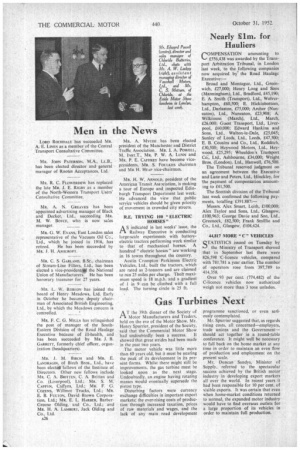Gas Turbines Next'
Page 28

If you've noticed an error in this article please click here to report it so we can fix it.
AT the 39th dinner of the Society of Motor Manufacturers and Traders, held on the eve of the Motor Show, Mr. Henry Spurrier, president of the Society, said that the Commercial Motor Show
had undoubtedly been a success. It showed that great strides had been made in the past two years.
The motor vehicle was little more than 60 years old, but it must be nearing the peak of its development in its present forms. Whilst there might still be improvements, the gas turbine must he looked upon as the next stage. Undoubtedly. an engine having rotating masses would eventually supersede the piston type.
Disturbing factors were currency exchange difficulties in important export markets; the ever-rising costs of production through increased taxation, prices of raw materials and wages. and the lack of any main road development programme sanctioned, or even seriously contemplated.
Mr. Spurrier suggested that, as regards rising costs, all concerned—employers, trade unions and the Government— should act together in a round-table conference. It might well be necessary to fall back on the home market at any time in order to maintain an even flow of production and employment on the present scale.
Mr. Duncan Sandys, Minister of Supply, referred to the spectacular success achieved by the British motor industry in developing export markets all over the world. In recent years it had been responsible for 10 per cent. of visible exports. It was certain that even when home-market conditions returned to normal, the expanded motor industry would have to find overseas outlets for a large proportion of its vehicles in order to maintain full production.












































































